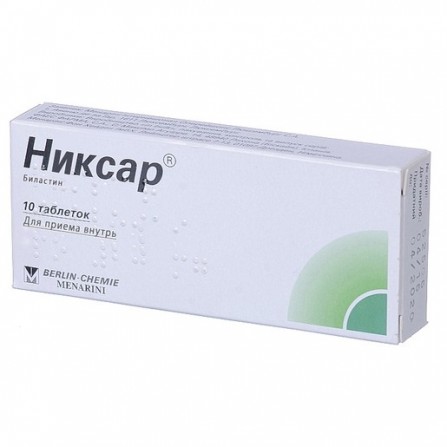More info
Description
Nixar contains the active substance bilastin - a long-acting antihistamine that selectively blocks peripheral H1 receptors. A significant therapeutic effect is observed an hour after taking the drug, the antihistamine effect persists for 24 hours. A slight penetration of bilastin through the blood-brain barrier is possible, but bilastin does not have a significant effect on the central nervous system and does not cause a sedative effect. It has no anticholinergic action. Elongation of the QT interval on the ECG is not observed.
Active ingredients
Bilustine
Release form
Pills
Composition
Bilustin, microcrystalline cellulose, sodium carboxymethyl starch (type A), colloidal silicon dioxide, magnesium stearate.
Indications
Allergic (seasonal and year-round) rhinoconjunctivitis: elimination or relief of symptoms (sneezing, nasal congestion, itching of the nasal mucosa, rhinorrhea, burning sensation and itching in the eyes, redness of the eyes, tearing), urticaria: elimination or reduction of pruritus, rash.
Use during pregnancy and lactation
Contraindicated in pregnancy and lactation.
Dosage and administration
Unless otherwise prescribed by a doctor, the following doses of Nixar are recommended for relieving the symptoms of allergic rhinoconjunctivitis and urticaria: adults and children over 12 years of age: 1 tablet of Nixar, which corresponds to 20 mg of bilastine, once a day. The maximum daily dose of bilastin is 20 mg, since increasing the dose does not lead to an increase in the therapeutic effect. A pill is taken one hour before meals or 2 hours after a meal (or fruit juice).
Side effects
Violations of the gastrointestinal tract. Infrequently: dryness of the oral mucosa, diarrhea, dyspepsia, gastritis, abdominal pain, pain in the upper abdomen, discomfort in the stomach, nausea. Violations of the skin and subcutaneous tissues. Infrequently: pruritus. Violations of the nervous system. Often: drowsiness, headache. Infrequently: dizziness. Psychiatric disorders. Infrequently: anxiety, insomnia. Metabolic disorders. Infrequently: increase in appetite, increase in body weight.Disturbances from an organ of hearing and labyrinth disturbances. Infrequently: tinnitus, vertigo. Disturbances from the respiratory system, organs of the chest and mediastinum. Infrequently: shortness of breath, dry nasal mucosa, discomfort in the nose. Violations of the cardiovascular system. Infrequently: blockade of the right leg of the bundle of His, sinus arrhythmia, lengthening of the QT interval on the electrocardiogram, other changes on the electrocardiogram. Infectious and parasitic diseases. Infrequently: herpetic lesion of the oral cavity. Others: thirst, fatigue, asthenia, fever, increased plasma triglyceride concentrations, increased plasma creatinine levels, increased activity of liver enzymes (aspartate aminotransferase, alanine aminotransferase, gamma glutamyl transferase).
Overdose
Symptoms: when applying bilastina in a dose that exceeds the recommended 10-11 times, side effects occurred 2 times more often than when using placebo. The most common symptoms were dizziness, headache, nausea. No serious side effects, including significant lengthening of the QT interval, were noted. Treatment: symptomatic and supportive therapy. There is no specific antidote.
Interaction with other drugs
With the simultaneous use of bilastin with ketoconazole or erythromycin, the area under the concentration-time curve (AUC) of bilastin increased by 2 times, and the maximum concentration (Cmax) - by 2-3 times. With the simultaneous use of bilastin at a dose of 20 mg and diltiazem at a dose of 60 mg Cmax with bilustin increased by 50%. Such effects can be explained by the interaction at the level of carrier proteins (including P-glycoprotein), which are responsible for removing drugs from intestinal cells, the substrate of which is bilastin. With the simultaneous use of bilastin and other drugs that are substrates or inhibitors of P-glycoprotein (for example, cyclosporine), the concentration of bilastin in the blood plasma may increase. Grapefruit and other fruit juices reduce the bioavailability of bilastin by 30%. This interaction is due to the ability of fruits to suppress the activity of the carrier protein of organic anions OATP1A2, for which bilustin is a substrate.Drugs that are substrates or inhibitors of OATP1A2 (for example, ritonavir or rifampicin) can reduce the concentration of bilastin in the blood plasma. Bilustin does not enhance the effect of ethanol on the central nervous system. With the simultaneous use of bilastine and lorazepam enhance, the overwhelming effect of lorazepam on the central nervous system was not detected.
special instructions
In patients with moderately severe renal failure (GFR 30-50 ml / min / 1.73 m2) and severe severity (GFR <30 ml / min / 1.73 m2), concurrent use with P-glycoprotein inhibitors may lead to an increase in bilastin concentration in blood plasma, which increases the risk of side effects. In this regard, in patients with moderate to severe renal failure, caution should be exercised with simultaneous use of bilastin with P-glycoprotein inhibitors (ketoconazole, erythromycin, cyclosporine, ritonavir, diltiazem, etc.).



